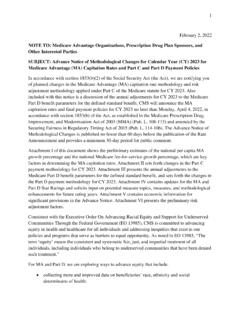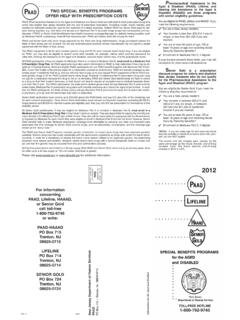Transcription of CY 2023 Medicare Advantage Proposed Rule: Impacts on Non ...
1 CY 2023 Medicare Advantage Proposed Rule: Impacts on Non-Medical supplemental BenefitsLast Updated: January 26, 20222CY2023 MAPD Proposed RULE: Impacts ON supplemental BENEFITSB ackground and Purpose On January 6, 2022, CMS released its Medicare Advantage and Part D Proposed rule: Medicare Program; Contract Year 2023 Policy and Technical Changes to the Medicare Advantage and Medicare Prescription drug Benefit Programs [CMS-4192-P].This deck is intended to provide stakeholders with a summary and insights into the key provisions impacting non-medical supplemental benefits in Medicare Advantage (MA).Non-medical supplemental benefits include benefits provided under both the expanded definition of primarily health-related benefits and Special supplemental Benefits for the Chronically Ill (SSBCI). For more information on these benefits, please visit our landing THIS SUMMARYN avigate directly to a section of this Rule summary: Standardizing Social Determinants of Health Questions in the Health Risk Assessment Maximum Out-of-Pocket Limits Coordination of supplemental Benefits Marketing and Communications Medical Loss Ratio Reporting3CY2023 MAPD Proposed RULE: Impacts ON supplemental BENEFITSD-SNPDual Eligible Special Needs Plans (D-SNPs) enroll individuals who are entitled to both Medicare and medical assistance from a state plan under Medicaid.
2 States cover some Medicare costs, depending on the state and the individual s Health-Related Benefits (PHRB)In 2018 (to go into effect for Calendar Year 2019), CMS expanded the scope of primarily health-related from simply an item or service whose primary purpose is to prevent, cure, or diminish an illness or injury to also include services that diagnose, prevent, or treat an illness or injury; compensate for physical impairments; act to ameliorate the functional/psychological impact of injuries or health conditions; or reduce avoidable emergency and healthcare SNPs are required to conduct an initial and annual (re)assessment of each enrollee s physical, psychological, and functional needs via a comprehensive risk assessment tool, the Health Risk Assessment (HRA).LTSSLong-Term Services and Supports (LTSS) are services, such as personal care, that individuals may require to perform activities of daily living, such as bathing and Affordable Care Act of 2010amended section 1857(e) of the Social Security Act to add new Medical Loss Ratio (MLR) requirements for MA plan s MLR is reported at the contract level and is expressed as a percentage, generally representing the percentage of revenue used for patient care, rather than for such other items as administrative expenses or Definitions and Acronyms (current/pre-Rule) Centers for Medicare and Medicaid Services 2019 Final Rule.
3 (April 2018). Centers for Medicare and Medicaid Services Website. Medical Loss Ratio. MAPD Proposed RULE: Impacts ON supplemental BENEFITSMOOPM aximum Out-of-Pocket (MOOP) limit that all Medicare Advantage plans must establish, beyond which amount the MA plan pays 100 percent of service costsMA supplemental BenefitsMA supplemental Benefits provide coverage for services that are not available in original, fee-for -service Medicare , such as dental CHRONIC Care Act, included in the Bipartisan Budget Act of 2018, created a new MA supplemental benefit category in statute: Special supplemental Benefits for the Chronically Ill (SSBCI). A chronically ill enrollee is defined as having one or more complex chronic conditions that are life threatening or reduce the health and functioning of the enrollee; having a heightened risk of hospitalization or other negative health outcomes.
4 And requiring coordination of may include services that are not primarily health-related, such as pest control or non-medical transportation, as long as the service has a reasonable expectation of improving or maintaining the health or overall function of the chronically ill marketing organizations (TPMOs) are entities such as a Field Marketing Organization (FMO), General Agent (GA), or similar type of organization that has been retained to sell or promote a Plan s/Part D Sponsor s Medicare products on the Plan s/Part D Sponsor s behalf either directly or through sales agents or a combination of Definitions and Acronyms (current/pre-Rule)3. Bipartisan Budget Act of 2018. Medicare Communications and Marketing Guidelines. (September 2018). MAPD Proposed RULE: Impacts ON supplemental BENEFITSP rovision: Standardizing Social Determinants of Health Questions in the Health Risk AssessmentSummaryImpactSNPs will have actionable information on Social Determinants of Health (SDOH) but lack authority to address the issues through SSBCI given that SDOH cannot currently be used as primary targeting criteria for SSBCI.
5 These standardized data could inform supplemental benefit design and can be useful for risk adjustment in the in 2024 or 2025, all SNPs will be required to include in their Health Risk Assessment (HRA) one or more standardized questions on the topics of housing stability, food security, and access to transportation. While SNPs will not be accountable for resolving all risks identified in the assessment questions, SNPs will be required to incorporate the results of the HRAs in individualized care plans and consult with enrollees about their unmet social needs. This may include taking steps to maximize access to supplemental benefits that may help address these to Table of Contents6CY2023 MAPD Proposed RULE: Impacts ON supplemental BENEFITSP rovision: Maximum Out-of-Pocket (MOOP) LimitsSummaryImpactCMS proposes to modify MOOP limits for dually eligible beneficiaries to include third-party payments (such as the State), even in instances where state lesser-of payment policy results in the State not paying an out-of -pocket spending on dually eligible beneficiaries will decrease as a result of MOOP limits being attained sooner.
6 Providers may be more willing to serve dually eligible beneficiaries, increasing their access to care. However, spending by MA plans will increase, with a higher impact on MA plans with lower MOOPs as part of their benefit package. This is estimated to cost MA organizations an additional $ per member per month (PMPM), or $ PMPM when accounting for the percentage of dually eligible enrollees with cost-sharing protections above the mandatory MOOP level. D-SNPs serving a large population of full benefit dually eligible individuals will be disproportionately impacted. Higher PMPM costs will potentially result in a reduction in the rebate dollars available for plans to spend on supplemental to Table of Contents7CY2023 MAPD Proposed RULE: Impacts ON supplemental BENEFITSP rovision: Coordination of supplemental BenefitsSummaryImpactWith the expansion of MA supplemental benefits to include non-medical services ( , LTSS and services to address social needs), there is increased opportunity for overlap in the benefits covered by D-SNPs and Medicaid.
7 supplemental benefits might be used to complement or fill gaps in Medicaid coverage. Currently, Medicare is the primary payer whenever Medicare and Medicaid cover the same services. CMS is seeking comment on how states and D-SNPs can further coordinate supplemental benefits. States will become increasingly aware of their ability to influence D-SNP supplemental benefits and clinical models, and in turn, Medicaid rates. However, supplemental benefit funding is considerably more limited than the cost of LTSS and services to address social needs. Therefore, these benefits should not become a substitute for Medicaid coverage. Additionally, this Proposed change may be complex for states, plans, and providers to operationalize given the dynamic nature of supplemental benefit structure and eligibility to Table of Contents8CY2023 MAPD Proposed RULE: Impacts ON supplemental BENEFITSP rovision: Marketing and CommunicationsSummaryImpactCMS has seen a significant increase in third-party marketing and in marketing-related beneficiary complaints attributed to third-party marketing organizations (TPMOs) activities.
8 As such, CMS proposes to define TPMOs more broadly and explicitly to capture the full range of types of entities that may be in a position of marketing Medicare health and drug plans. TPMOs will be required use a standardized disclaimer that states that they do not offer every plan available in beneficiaries area. Plans will also be responsible for greater oversight of general, TPMOs will be more tightly regulated, and plans will be responsible for greater oversight. supplemental benefits are often cited in marketing activities to attract beneficiaries to certain plans. There is an opportunity for new requirements and increased accountability for these entities to be leveraged to help address confusion around the availability of and eligibility criteria for supplemental to Table of Contents9CY2023 MAPD Proposed RULE: Impacts ON supplemental BENEFITSP rovision: Medical Loss Ratio (MLR) ReportingSummaryStarting in 2023, plans will be required to submit to CMS the data needed to calculate and verify the MLR and remittance amount, if any, for each contract, including the amounts of incurred claims for Medicare -covered supplemental benefits.
9 For the first time, expenditures will be separately reported for the following supplemental benefit types or categories:Return to Table of ContentsoDentaloVisionoHearingoTransport ationoFitness BenefitoWorldwide Coverage / Visitor TraveloOver the Counter (OTC) ItemsoRemote Access TechnologiesoMealsoRoutine Foot CareoOut-of-network ServicesoAcupuncture TreatmentsoChiropractic CareoPersonal Emergency Response System (PRS)oHealth EducationoSmoking and Tobacco Cessation CounselingoAll Other Primarily Health Related supplemental BenefitsoNon-Primarily Health Related Items and Services that are Special supplemental Benefits for the Chronically Ill (SSBCI)10CY2023 MAPD Proposed RULE: Impacts ON supplemental BENEFITSP rovision: Medical Loss Ratio (MLR) Reporting (Continued)ImpactCollection and public release of expenditure data would provide greater transparency into spending and utilization for supplemental benefits, which will be valuable data for policymakers, researchers, beneficiaries, and the general public.
10 This information will allow beneficiaries to compare spending on supplemental benefits between plans. However, since all benefit categories would be rolled up into a single line each for expanded primarily health-related benefits and SSBCI, insights into spending on and utilization of specific benefit types within these categories will be to Table of ContentsSummary (continued)Expenditure data will be publicly reported no sooner than 18 months after the end of the applicable contract year. Data will not be released when they would reveal plan-level expenditures for a specific benefit offered under a single MAPD Proposed RULE: Impacts ON supplemental BENEFITS For more information on these benefits How plans and providers partner to offer these benefits Policy opportunities for these benefits Past analyses, and Additional resources See the Advancing Non-Medical supplemental Benefits in Medicare Advantage landing page on ATI s websiteFor More Information:Return to Table of Contents12CY2023 MAPD Proposed RULE: Impacts ON supplemental BENEFITSA cknowledgment This body of work is supported by a grant from The SCAN Foundation, advancing a coordinated and easily navigated system of high-quality services for older adults that preserve dignity and independence.


